#IoT Division
Explore tagged Tumblr posts
Text
IoT development solutions for hospitals in South Africa Revolutionize healthcare in South Africa with Mobiloitte's IoT Development Solutions tailored for hospitals. Our cutting-edge technology enhances patient care, streamlines operations, and improves resource management. Monitor equipment, ensure patient safety, and reduce costs with our user-friendly solutions. Embrace innovation and deliver world-class healthcare. Partner with Mobiloitte, your trusted South African IoT development experts.

#IoT Development Solutions#Integrating IoT#IoT Services#IoT & Emerging Technologies#IoT Solutions for Smart Applications#IoT Division#Product Development Channel#IoT Automation Solutions#IoT systems#IoT Solutions for Education#iot in gaming#iot in biotechnology#iot solutions for hotels#iot in hospitality industry#smart home iot solutions#iot solutions for transportation#blockchain iot app development company#blockchain iot software development company#IoT application development services
0 notes
Text
So here's something that someone said to me a few days ago which seems kind of obvious once you've heard it, but which merits mention nonetheless: In the past, before the world wars, inventions were made primarily by individual inventors or small groups of inventors looking to apply them to actual human concerns; now, new technologies come about largely through industrial r & d divisions, and were made specifically to boost shareholder value. The present seems bewildering and the future unknowable and kind of horrifying because huge sociotechnical transformations like AI and IoT are being driven not by actual human concerns or desires, but purely by the interests of capital. Human agency is no longer in the driver's seat, and we are going somewhere that most of us very much do not want to go. It's the difference between the late-Victorian inventor-hero and cyberpunk.
Anyways, we need to seize the means of invention.
319 notes
·
View notes
Text
Cyberspace Sentinels: Tracing the Evolution and Eccentricities of ICE
As we hark back to the embryonic stages of cyber defense in the late 1990s, we find ourselves in a digital petri dish where the first firewalls and antivirus programs are mere amoebas against a sea of threats. The digital defenses of yore, much like the drawbridges and moats of medieval castles, have transformed into a labyrinth of algorithms and machine learning guards in today's complex cybersecurity ecosystem. The sophistication of these systems isn't just technical; it's theatrical.
The drama unfolds spectacularly in the cyberpunk genre, where Intrusion Countermeasures Electronics (ICE) are the dramatis personae. Let's peruse the virtual halls of cyberpunk media to encounter the most deadly, and delightfully weird, iterations of ICE, juxtaposing these fictional behemoths against their real-world counterparts.
We commence our odyssey with William Gibson’s "Neuromancer," where ICE is not only a barrier but a perilous landscape that can zap a hacker's consciousness into oblivion. Gibson gives us Black ICE, a lethal barrier to data larceny that kills the intruding hacker, a grim forerunner to what cybersecurity could become in an age where the stakes are life itself.
CD Projekt Red’s "Cyberpunk 2077" gives us Daemons, digital Cerberuses that gnash and claw at Netrunners with malevolent intent. They symbolize a cyber-Orwellian universe where every keystroke could be a pact with a digital devil.
The chromatic haze of "Ghost in the Shell" offers ICE that intertwines with human cognition, reflecting a reality where software not only defends data but the very sanctity of the human mind.
In Neal Stephenson’s "Snow Crash," the Metaverse is patrolled by ICE that manifests as avatars capable of digital murder. Stephenson's vision is a reminder that in the realm of bytes and bits, the avatar can be as powerful as the sword.
"Matrix" trilogy, portrays ICE as Sentinels — merciless machines tasked with hunting down and eliminating threats, a silicon-carbon ballet of predator and prey.
On the small screen, "Mr. Robot" presents a more realistic tableau — a world where cybersecurity forms the battleground for societal control, with defense systems mirroring modern malware detection and intrusion prevention technologies.
"Ready Player One," both the novel and Spielberg's visual feast, portrays IOI’s Oology Division as a form of corporate ICE, relentless in its pursuit of control over the Oasis, guarding against external threats with a militaristic zeal that mirrors today's corporate cybersecurity brigades.
And let’s not overlook the anarchic "Watch Dogs" game series, where ICE stands as a silent sentinel against a protagonist who uses the city’s own connected infrastructure to bypass and dismantle such defenses.
Now, let us tether these fictional marvels to our reality. Today’s cybersecurity does not slumber; it's embodied in the form of next-gen firewalls, intrusion prevention systems, and advanced endpoint security solutions. They may not be as visceral as the ICE of cyberpunk, but they are no less sophisticated. Consider the deep packet inspection and AI-based behavioral analytics that cast an invisible, ever-watchful eye over our digital comings and goings.
Nevertheless, the reality is less bloodthirsty. Real-world cyber defense systems, as advanced as they may be, do not threaten the physical well-being of attackers. Instead, they stealthily snare and quarantine threats, perhaps leaving cybercriminals pining for the days of simple antivirus skirmishes.
But as the cyberverse stretches its tendrils further into the tangible world, the divide between the fantastical ICE of cyberpunk and the silicon-hardened guardians of our networks grows thin. With the Internet of Things (IoT) binding the digital to the physical, the kinetic potential of cybersecurity threats — and therefore the need for increasingly aggressive countermeasures — becomes apparent.
Could the ICE of tomorrow cross the Rubicon, protecting not just data, but physical well-being, through force if necessary? It is conceivable. As cyberpunk media illustrates, ICE could morph from passive digital barricades into active defenders, perhaps not with the murderous flair of its fictional counterparts but with a potency that dissuades through fear of tangible repercussions.
In the taut narrative of cybersecurity’s evolution, ICE remains the enigmatic, omnipresent sentinel, an avatar of our collective desire for safety amidst the binary storm. And while our reality may not yet feature the neon-drenched drama of cyberpunk's lethal ICE, the premise lingers on the periphery of possibility — a silent admonition that as our digital and physical realms converge, so too might our defenses need to wield a fiercer bite. Will the cyberpunk dream of ICE as a dire protector manifest in our world? Time, the grand weaver of fate, shall unfurl the tapestry for us to see.
- Raz
29 notes
·
View notes
Text

Boeing F-15EX completes first phase of integrated testing
Fernando Valduga By Fernando Valduga 09/14/2023 - 11:00am in Military
The F-15EX recently completed the first phase of its initial operational test and evaluation (IT&E) program with the launch of an AGM-158 joint air-surface missile (JASSM), the highest-range air-to-ground missile in the U.S. Department of Defense combat inventory.
The JASSM has a range of about 230 miles, according to a U.S. Air Force information leaflet.
The F-15EX is the first U.S. Air Force aircraft to undergo an integrated program of tests and evaluations. The combination of the IOT&E and DOT&E effort is unique to the program, in that the existing test data of the legacy F-15C/D and F-15E can be compared with the data from the new EX, with a special focus on the new features unique to EX, such as its advanced processor and fly-by-wire control system. The EX also has more weapon stations than the F-15E, allowing it to carry more war material.

In November 2022 tests, the F-15EX demonstrated that it can carry up to 12 AIM-120 AMRAAM air-to-air missiles.
“Proving the ability of the F-15EX to employ three JASSMs after witnessing the validation of the air-to-air domain paper with a load of 12 AMRAAM that it can fire is incredible,” said Major Calvin Conner, commander of the F-15 division of the 85º Test and Evaluation Squadron. "The firepower that four F-15EX jets bring to a combatant commander is tremendous."

JASSM was launched during the Combat Hammer exercise, held at Hill Air Base in Utah in August. The shot was performed simultaneously with the 53ª Wing Weapon System Evaluation Program, which required a collaborative effort between the 83º and 86º Fighter Weapon Squadrons. The details of the shot - the targets, ranges, etc. - are confidential, but have been strongly evaluated, from the construction of the weapon to the use and analysis of the missile routes, to the target.
"This test shows innovation and results in the rapid delivery of state-of-the-art capabilities to the fighter. That's exactly what our fighters need from us," said Mark Sears, vice president of Boeing Fighters. "The F-15EX is the most affordable and immediate way to renew the capacity and upgrade the capabilities of the U.S. Air Force and we are ready to deliver additional aircraft later this year."
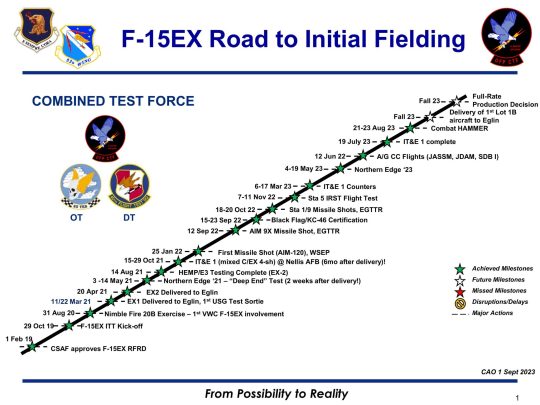
With Phase I of the F-15EX IT&E completed, the data from this phase will be analyzed for the final report to guide a total production decision determination in the coming months.
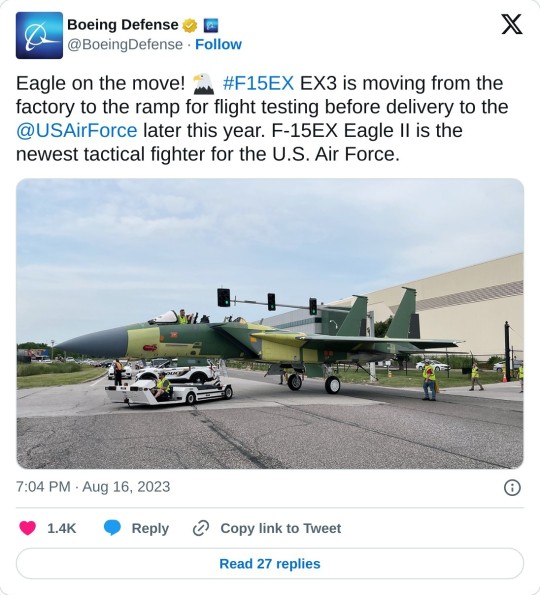
The U.S. Air Force plans to buy 104 F-15EX fighters, although this number could rise to 110 if some changes to the 2024 fiscal year defense bill are enacted.

Boeing begins delivering fighters with combat capability to U.S. Air Force squads later this year.
Tags: Military AviationBoeingF-15EXUSAF - United States Air Force / U.S. Air Force
Sharing
tweet
Fernando Valduga
Fernando Valduga
Aviation photographer and pilot since 1992, he has participated in several events and air operations, such as Cruzex, AirVenture, Daytona Airshow and FIDAE. He has work published in specialized aviation magazines in Brazil and abroad. Uses Canon equipment during his photographic work throughout the world of aviation.
Related news
F-35A Lightning II fighter of the Republic of Korea Air Force (RoKAF). (Photo: Liz Lutz / Lockheed Martin)
MILITARY
Approved the purchase of 25 more F-35 fighters by South Korea
14/09/2023 - 08:37
MILITARY
Airbus delivers first C295 aircraft to India
13/09/2023 - 19:18
HELICOPTERS
Lockheed Martin offers Black Hawk to request new medium helicopter from the United Kingdom
13/09/2023 - 18:59
Arrival of the first B-52 at the Boeing unit in San Antonio, Texas, for AESA radar installation.
MILITARY
Raytheon delivers first AESA radar to Boeing for B-52 modernization
09/13/2023 - 16:00
The high-altitude, long-lived RQ-4D Phoenix unmanned aircraft are launched and controlled from Sigonella Air Base in Sicily. (Photo: NATO)
MILITARY
UKRAINE: NATO Drone Unit provided hundreds of flight hours collecting critical information
09/13/2023 - 14:00
BRAZIL
IMAGES: How the FAB is acting in support of those affected by the flood in RS
09/13/2023 - 1:00 PM
10 notes
·
View notes
Text



Looking forward to China’s industrial development prospects in the next 10 years
Looking forward to China's industrial development in the next 10 years, analysis and predictions can be made based on existing development trends, policy orientations and the global economic environment:
Industrial upgrading and structural optimization:
China will continue to promote the upgrading of its industrial structure from labor-intensive to technology- and capital-intensive. Mid- to high-end manufacturing will be the key development direction, including aerospace, high-end equipment, new energy vehicles, new materials and other fields. With the deepening implementation of the "Made in China 2025" strategy and subsequent planning, China will accelerate the in-depth integration of industrialization and informatization, and promote the development of emerging industries such as intelligent manufacturing and the industrial Internet. Innovation drive and technological progress:
Against the background of intensified global technological competition, China will further increase investment in technological innovation, especially in fields such as 5G, artificial intelligence, Internet of Things (IoT), quantum information, and biotechnology, to enhance the core competitiveness of the industry. Industry 4.0 related technologies and digital transformation will become mainstream. Enterprises will improve production efficiency and product quality through automation and intelligent transformation, and achieve personalized customization and flexible production. Green and sustainable development:
Environmental protection policies are becoming stricter, and low-carbon economy and circular economy will have a profound impact on the path of industrial development. China's industry will be committed to energy conservation and emission reduction, clean production, and the development of green manufacturing systems, such as new energy, energy-saving and environmental protection equipment and services.
Globalization and industrial chain reconstruction:
Taking into account the rise of trade protectionism and the adjustment trend of global supply chains, Chinese industry will actively build independent and controllable industrial and supply chains, seek a higher position in the global value chain, and enhance international competitiveness. While low-end industries are being transferred, China will strengthen international cooperation in some areas, actively participate in the global industrial division of labor, and build international brands and multinational companies. Talent training and system reform:
Facing the challenge of aging, China will pay more attention to the cultivation and introduction of talents, improve the quality of the labor force, especially the construction of highly skilled talent teams, to support the development needs of high-end industries. Deepen institutional reform, create a better business environment, encourage innovation and entrepreneurship, promote the development of small, medium and micro enterprises, and stimulate market vitality. To sum up, in the next ten years, China's industry will focus on high-quality development, focus on technological innovation, industrial chain upgrading, green development and improvement of global competitiveness, and strive to achieve the leap from a manufacturing country to a manufacturing power. At the same time, we will also respond to the challenges brought about by changes in the internal and external environments, continue to deepen reforms, and ensure the stable and healthy development of the industrial economy.
2 notes
·
View notes
Text
Closer Look at 400G QSFP-DD Optical Transceiver Module
Recent years have seen the evolution towards the 5G, Internet of Things (IoT), and cloud computing, increasing pressure on data centers to ramp up both network capacity to 400G and driving providers to search for new solutions to achieve their 400G Data Center Interconnects (DCIs). 400G QSFP-DD optical transceiver module is becoming one of the most popular cutting-edge 400G DCI solutions. This article will provide a basic understanding of QSFP-DD optical transceiver modules.
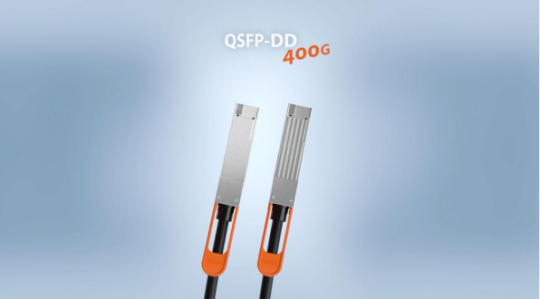
What is the QSFP-DD Optical Transceiver Module?
Quad small form-factor pluggable-double density (QSFP-DD) is designed with eight lanes that operate at up to 25 Gbps via NRZ modulation or 50 Gbps via PAM4 modulation. It supports data rates of 200 Gbps or 400 Gbps and doubles the density. QSFP-DD is backward compatible with current 40G and 100G QSFPs. It is compliant with IEEE802.3bs and QSFP-DD MSA standards. QSFP-DD is available in single-mode (SM) and multi-mode (MM) fiber optic cables and includes digital diagnostics monitoring (DDM) to monitor parameters such as power, temperature, and voltage.
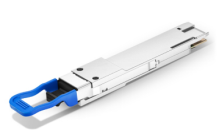
Types of 400G QSFP-DD Optical Transceiver Module
400G SR8 QSFP-DD
400G SR8 QSFP-DD optical transceiver module is suitable for short-distance interconnection or multi-channel data communication. The transmission rate is up to 425Gbps, and the central wavelength is 850nm. The transmission distance is up to 70m or 100m through multi-mode OM3 and OM4 fiber.
400G DR4 QSFP-DD
400G DR4 QSFP-DD optical transceiver module achieves the transmission over single-mode fiber (SMF) with an MPO-12 connector. It supports a max transmission distance of 500m on SMF.
400G FR4 QSFP-DD
400G FR4 QSFP-DD optical transceiver module supports link lengths of up to 2km SMF with a duplex LC connector. It uses wavelength division multiplexing(CWDM ) technology, eight channels of 53Gbps PAM4 signals on the electrical side, and four channels of 106Gbps PAM4 signals on the optical side, which is twice the rate of the electrical side.
400G LR4 QSFP-DD
400G LR4 QSFP-DD optical transceiver module is designed with a built-in Gearbox chip that multiplexes the two channels' electrical input data into a single-channel outputs signal and then modulates it to the optical receiver end. The digital signal processor (DSP) basis gearbox converts eight channels of 25GBaud PAM4 signals into four channels of 50GBaud (PAM4) over an SMF cable with duplex LC connectors. It supports a transmission distance of up to 10km.
400G LR8 QSFP-DD
The 400GBASE-LR8 optical transceiver module supports link lengths of up to 10km over a standard pair of G.652 SMF with duplex LC connectors.
400G ER8 QSFP-DD
The 400G ER8 QSFP-DD optical transceiver module supports link lengths of up to 40km over a standard pair of G.652 SMF with duplex LC connectors.
400G ER4 QSFP-DD
400G ER4 QSFP-DD optical transceiver module supports link lengths of up to 40km over a standard pair of G.652 SMF with duplex LC connectors. It has only four wavelengths for 4 LAN WDM channels 1295.56/1300.05/1304.58/1309.14nm.
Advantages of 400G QSFP-DD Optical Transceiver Module
Backward compatibility: Allowing the QSFP-DD to support existing QSFP modules (QSFP+, QSFP28, QSFP56, etc.). It provides flexibility for end-users and system designers.
Adopting the 2x1 stacked integrated cage/connector to support the one-high cage connector and two-high stack cage connector system.
SMT connector and 1xN cage design: Enable thermal support of at least 12W per module. The higher thermal reduces the requirement for heat dissipation capabilities of transceivers, thus reducing some unnecessary costs.
ASIC design: Supporting multiple interface rates and fully backward compatible with QSFP+ and QSFP28 modules, thus reducing port and equipment deployment costs.
Applications
400G QSFP-DD optical transceiver module is used in 400G Ethernet, data centers, telecommunications networks, cloud networks, Infiniband interconnects, high-performance computing networks, 5G, 4K video, IoT, etc.
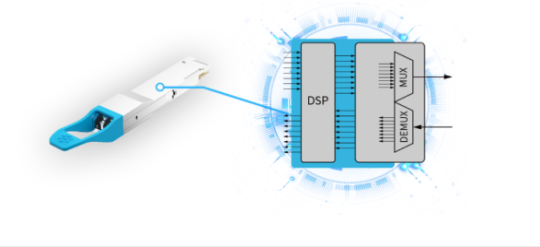
Conclusion
400G QSFP-DD optical transceiver module offers high speed, performance, scalability, and low power in 400G Ethernet. Sun Telecom specializes in providing one-stop total fiber optic solutions for all fiber optic application industries worldwide. Contact us if any needs.
2 notes
·
View notes
Text
A list of Automotive Engineering Service Companies in Germany

Bertrandt AG, https://www.bertrandt.com/. Bertrandt operates in digital engineering, physical engineering, and electrical systems/electronics segments. Its Designing function includes designing of all the elements of the automotive.
Alten Group, https://www.alten.com/. ALTEN Group supports the development strategy of its customers in the fields of innovation, R&D and technological information systems. Created 30 years ago, the Group has become a world leader in Engineering and Technology consulting. 24 700 highly qualified engineers carry out studies and conception projects for the Technical and Information Systems Divisions of major customers in the industrial, telecommunications and Service sectors.
L&T Technology Services Limited, https://www.ltts.com/. LTTS’ expertise in engineering design, product development, smart manufacturing, and digitalization touches every area of our lives — from the moment we wake up to when we go to bed. With 90 Innovation and R&D design centers globally, we specialize in disruptive technology spaces such as EACV, Med Tech, 5G, AI and Digital Products, Digital Manufacturing, and Sustainability.
FEV Group GmbH, https://www.fev.com/. FEV is into the design and development of internal combustion engines, conventional, electric, and alternative vehicle drive systems, energy technology, and a major supplier of advanced testing and instrumentation products and services to some of the world’s largest powertrain OEMs. Founded in 1978 by Prof. Franz Pischinger, today the company employs worldwide highly skilled research and development specialists on several continents.
Harman International, https://www.harman.com/. HARMAN designs and engineers connected products and solutions for automakers, consumers, and enterprises worldwide, including connected car systems, audio and visual products, enterprise automation solutions; and services supporting the Internet of Things.
EDAG Engineering GmbH, https://www.edag.com/de/. EDAG is into vehicle development, plant planning and construction, and process optimization.
HCL Technologies Limited, http://www.hcltech.com/. HCL Technologies Limited is an Indian multinational information technology services and consulting company headquartered in Noida. It emerged as an independent company in 1991 when HCL entered into the software services business. The company has offices in 52 countries and over 210,966 employees.
Cientra GmbH, https://www.cientra.com/. Cientra expertise across VLSI, ASIC, FPGA, SoC engineering, and IoT accelerate our delivery of customized solutions to the Consumer, Aviation, Semiconductors, Telecom, Wireless, and Automotive industries across their product lifecycle.
Akka Technologies, https://www.akka-technologies.com/. AKKA supports the world’s leading industry players in their digital transformation and throughout their entire product life cycle.
IAV GmbHb, https://www.iav.com/en/. IAV develops the mobility of the future. Regardless of the specific manufacturer, our engineering proves itself in vehicles and technologies all over the world.
Altran Technologies, https://www.altran.com/in/en/. Altran expertise from strategy and design to managing operations in the fields of cloud, data artificial intelligence, connectivity, software, digital engineering, and platforms.
Capgemini Engineering, https://capgemini-engineering.com/de/de/. Capgemini Engineering is a technology and innovation consultancy across sectors including Aeronautics, Space, Defense, Naval, Automotive, Rail, Infrastructure & Transportation, Energy, Utilities & Chemicals, Life Sciences, Communications, Semiconductor & Electronics, Industrial & Consumer, Software & Internet.
2 notes
·
View notes
Text
Gil Rosen, Chief Marketing Officer at Amdocs – Interview Series
New Post has been published on https://thedigitalinsider.com/gil-rosen-chief-marketing-officer-at-amdocs-interview-series/
Gil Rosen, Chief Marketing Officer at Amdocs – Interview Series


Gil Rosen is Chief Marketing Officer at Amdocs, responsible for managing its global brand, product marketing and customer marketing. In this role, he leads development of Amdocs’ vision, delivery of strategic research insights to customers, as well as the company’s overall go-to-market activities. Gil heads a team of global marketing professionals and is a member of the company’s executive management team. Prior to assuming the CMO role, Gil was Division President of amdocs:next, responsible for cultivating and incubating future growth engines and disruptive technologies, including IoT and the AI-powered home broadband experience.
Can you share how your extensive background in marketing, innovation, and technology has shaped your vision for Amdocs and its role in the telecom industry?
Having worked on both sides of the telecom industry, from launching award-winning devices and cloud services to leading marketing and innovation at Deutsche Telekom and Bezeq, I’ve seen firsthand how technology transforms lives. At Amdocs, my unique position provides a global perspective, allowing me to align our products with the vision we uncover through our extensive research. My focus is on enabling our customers to build better experiences for their customers while pushing the boundaries of what’s possible with technologies like generative AI.
Amdocs has positioned itself as a leader in the telecommunications and media sectors. What differentiates Amdocs from its competitors in the generative AI space?
Amdocs has been working with leading global service providers for over 40 years. Our leadership comes from staying ahead of technological shifts like broadband, cloud, and 5G, and now helping our customers navigate the agentic era. Understanding data is critical for AI, and we’ve embedded this expertise into our telecom-GPT platform, amAIz, which addresses CSP-specific challenges like customer experience, operational efficiencies and more. Unlike generic, consumer-facing AI solutions, amAIz enhances customer support, optimizes operations, and scales intelligently. Our relationships with customers go beyond software and services; we work as true partners, offering solutions that are agnostic to LLMs or cloud providers.
Can you elaborate on the role of Amdocs’ amAIz platform in transforming customer and operational experiences for CSPs?
The amAIz platform demonstrates how GenAI can revolutionize telecom by combining hyper-personalized customer interactions with operational efficiency. It enables proactive issue resolution, automates repetitive tasks, and scales effortlessly. For instance, a North American provider using amAIz saw a 63% reduction in handling time, 50% better first-time resolution, and a 49% boost in Transactional Net Promoter Score. These improvements are profound for the industry and highlight how new technologies in the right hands can significantly enhance both efficiency and more personalized customer experiences.
The report, Rethinking Brand and Customer Experience in the Agentic Era, highlights a significant gap between consumer expectations and CSP perceptions of AI agents. How should CSPs address this disconnect to better align with consumer needs and strengthen their brand identity?
The gap stems from two key issues: CSPs often focus on behind-the-scenes operational goals that customers don’t notice, and they underestimate how ready consumers are to embrace GenAI. For example, only 45% of consumers express concerns about GenAI in customer care, yet CSPs estimate this number at 60%.
As we enter the agentic era, AI agents are no longer just tools—they’re brand representatives and often preferred by consumers, shaping relationships by communicating in the brand’s voice and reflecting its values. CSPs must rethink their approach to create AI experiences that adapt dynamically to context and deliver meaningful, personalized interactions. With our research showing lower levels of satisfaction with current chatbots as compared with human agents, there’s clear room for improvement. To thrive, CSPs must ensure AI agents deliver meaningful, personalized experiences that meet today’s high consumer expectations and build trust.
The report also highlights that 80% of consumers expect empathy from AI agents, yet only 43% of CSPs recognize this. How can brands design AI agents to meet such emotional and contextual needs?
Empathy starts with understanding the brand, context, and customer. Brands must recognize that empathy is critical in service-oriented interactions—like resolving a lost phone issue or unexpected billing shocks—but may be less important in adding services like adding international travel plans. By adjusting tone and engagement based on context, CSPs can balance empathy with practicality. Advanced natural language capabilities, diverse datasets, and feedback loops help refine these interactions to ensure they remain authentic and aligned with customer expectations.
With 61% of consumers willing to switch to CSPs offering superior AI agents, what immediate steps should providers take to enhance their AI offerings?
CSPs must act decisively by launching GenAI pilots to address engagement gaps, gathering customer feedback, and refining capabilities. However, marketing and brand leaders must take charge and lead these discussions—not let technology teams operate in silos. Current chatbots enabled by technology teams often fall short, and evolving AI agents requires a more strategic, brand-led approach that transcends technology alone.
Now that AI agents are becoming extensions of brand identity, what strategies should brands implement to ensure their AI agents reflect their core values and meet customer expectations?
To succeed, CSPs must define their AI agents’ personalities with precision—aligning tone, behavior, and messaging with brand values. Continuous training and governance will ensure these agents remain aligned with core values and responsive to evolving customer needs.
How do you foresee the evolution of AI agent personalities and their customization influencing brand loyalty in the long term?
AI agents will become more than tools—they’ll orchestrate and act, making them pivotal brand ambassadors. In the long term, it’s possible these agents could achieve a level of recognition comparable to celebrity endorsements, much like Ryan Reynolds with Mint Mobile. With well-maintained content and engaging social interactions, AI agents could become icons that embody brand identity, driving deeper loyalty.
What are your predictions for the telecommunications industry in the next five years as generative AI and platforms like amAIz become more prevalent?
Generative AI will redefine customer engagement, enabling CSPs to deliver improved experiences at scale. Our children won’t understand the concept of being put on hold. AI agents will deliver fast, friendly support in native languages and dialects, without the variability of human emotion. On the network side, AI will maximize ROI by optimizing resource usage, ensuring networks operate as efficiently as possible. CSPs that fail to adapt risk falling into irrelevance.
As a leader in this space, what excites you most about the agentic era and its potential impact on society?
What excites me most is the potential to create meaningful, empathetic interactions between brands and consumers. Agents are becoming the new “apps”, and everyone could eventually have their own personal one. Why search or fill out forms when your own personal agent can handle it all itself? In time, these agents may even communicate with each other, automating tasks seamlessly in the background. With this, the future holds more conversational, humanized digital interactions that simplify and enhance daily life.
Thank you for the great interview, readers who wish to learn more should visit Amdocs.
#5G#agent#agents#ai#ai agent#AI AGENTS#AI-powered#amdocs#American#approach#apps#background#Behavior#brands#chatbots#Children#Cloud#cloud providers#cloud services#consumers#content#continuous#CSP#CSPs#customer engagement#customer experience#customer experiences#data#datasets#Design
0 notes
Text

The Future of Technology: Why You Should Choose an Embedded Systems Course
In today’s tech-driven world, Embedded Systems have become the backbone of modern innovation. From smart home devices to advanced automotive systems, Embedded Systems are at the heart of every groundbreaking technology. If you are passionate about technology and aspire to build a career in a highly rewarding field, enrolling in an Embedded Systems course is the right choice. Here’s everything you need to know about this dynamic field and why QIS Academy’s Embedded Systems training in Kerala is your best bet for success.
What Are Embedded Systems?
Embedded Systems are specialized computing systems designed to perform specific tasks within larger devices. These systems integrate hardware and software seamlessly to control various functions, from processing data to managing sensors and actuators. They are widely used in industries such as automotive, healthcare, consumer electronics, aerospace, and telecommunications.
Why Pursue a Career in Embedded Systems?
High Demand in the Job Market: With the rapid growth of IoT, automation, and smart technologies, the demand for skilled Embedded Systems professionals is skyrocketing. Companies are constantly on the lookout for experts who can design, develop, and maintain these systems.
Diverse Career Opportunities: A career in Embedded Systems opens doors to various roles such as Embedded Software Engineer, Hardware Designer, Firmware Developer, IoT Engineer, and Automotive Systems Specialist. These roles offer not only financial stability but also the chance to work on innovative projects.
Innovation and Creativity: Embedded Systems professionals play a key role in creating innovative solutions. Whether it’s developing smart wearables or autonomous vehicles, the possibilities for creative problem-solving are endless.
Attractive Salaries: Due to the specialized nature of the field, Embedded Systems experts command competitive salaries, with opportunities for rapid growth and career advancement.
What Makes QIS Academy the Best Choice for Embedded Systems Training in Kerala?
QIS Academy, a division of Quest Innovative Solutions, is renowned for its industry-relevant training programs. Here’s why QIS Academy stands out as the premier destination for Embedded Systems training:
Comprehensive Curriculum: The course covers all aspects of Embedded Systems, including microcontrollers, real-time operating systems (RTOS), hardware-software integration, and debugging techniques. The curriculum is regularly updated to align with the latest industry trends.
Hands-On Training: At QIS Academy, learning goes beyond theory. Students engage in hands-on projects that simulate real-world scenarios, ensuring they gain practical experience in designing and implementing Embedded Systems.
Expert Trainers: The training is conducted by highly qualified professionals with extensive industry experience. Their guidance ensures students are well-prepared to meet the challenges of the field.
State-of-the-Art Facilities: The academy is equipped with modern labs and tools, providing students with a conducive environment for learning and experimentation.
Placement Assistance: QIS Academy offers robust placement support, connecting students with leading IT companies and MNCs. The academy’s strong industry ties ensure students have access to lucrative job opportunities.
Flexible Learning Options: With centers in Kochi, Calicut, Trivandrum, and Kannur, QIS Academy makes it convenient for students across Kerala to access quality training.
Course Highlights
The Embedded Systems course at QIS Academy is designed to transform beginners into industry-ready professionals. Here’s a glimpse of what the course offers:
Introduction to Embedded Systems: Basics of embedded hardware and software.
Microcontroller Programming: Hands-on training with popular microcontrollers like ARM, AVR, and PIC.
RTOS and Multitasking: Learn to design systems with real-time constraints.
Peripheral Interfacing: Work with sensors, actuators, and communication protocols such as UART, I2C, and SPI.
Embedded C and Firmware Development: Master programming techniques specific to Embedded Systems.
Debugging and Testing: Develop skills to identify and resolve system issues effectively.
Who Can Enroll?
The course is ideal for:
Fresh graduates in engineering (ECE, EEE, CSE, etc.)
Professionals looking to upgrade their skills
Enthusiasts passionate about Embedded Systems and IoT
Career Prospects
Graduates of the Embedded Systems course can explore exciting career paths in various industries:
Automotive: Developing advanced driver-assistance systems (ADAS) and infotainment systems.
Healthcare: Designing medical devices and equipment.
Consumer Electronics: Working on smart appliances and wearables.
Aerospace: Building avionics and control systems.
IoT: Creating smart city solutions and connected devices.
Why Kerala is the Ideal Destination for Embedded Systems Training
Kerala is emerging as a hub for technology and innovation, with numerous startups and established companies investing in Embedded Systems and IoT. The state’s strong focus on education and infrastructure makes it an ideal location for skill development. QIS Academy leverages this environment to provide top-notch training and career opportunities for students.
Success Stories at QIS Academy
QIS Academy takes pride in the success of its students, many of whom have secured positions in leading companies. The academy’s alumni network serves as a testament to the quality of training and support provided.
Conclusion
Enrolling in an Embedded Systems course is a smart investment in your future. With its high demand, diverse opportunities, and scope for innovation, the field promises a fulfilling career. At QIS Academy, we are committed to shaping the next generation of tech leaders through our comprehensive training programs. Join us today and take the first step towards an exciting career in Embedded Systems. Admissions are open for the new batch – don’t miss this opportunity!
#Embedded System course kerala#embedded and automotive systems course in kerala#Embedded System course#Embedded systems training in kerala
0 notes
Text
Revolutionizing Quality: Top Software Testing Service Companies for 2025

The software industry has evolved significantly over the past few decades, and with this evolution, the importance of Software Testing Services has become more prominent than ever. Businesses worldwide rely on software testing to ensure their products are robust, secure, and user-friendly. Software Testing and Quality Assurance Services are crucial for maintaining reliability and delivering a seamless user experience. In this blog, we’ll explore the top 10 Software Testing Service Companies that have set a benchmark in the industry.
1. Vee Technologies
When it comes to Software Testing Services, Vee Technologies stands out as a leader in delivering end-to-end solutions. With years of experience and expertise, Vee Technologies has earned its reputation as a trusted Software Testing Service Company that ensures high-quality results for its clients.
Key Offerings:
Functional Testing: Ensures that the software behaves as expected and meets user requirements.
Automation Testing: Streamlines the testing process by leveraging cutting-edge tools and frameworks.
Performance Testing: Validates the software's responsiveness, scalability, and stability under various conditions.
Security Testing: Identifies vulnerabilities and strengthens the software against potential threats.
Vee Technologies combines cutting-edge technology, industry expertise, and a customer-centric approach to deliver Software Testing and Quality Assurance Services that help businesses thrive. Whether it’s a start-up or a Fortune 500 company, Vee Technologies has the resources and expertise to cater to diverse testing needs.
2. Infosys
Infosys has consistently been at the forefront of innovation in IT services, and their software testing division is no exception. The company’s robust Software Testing Services focus on delivering flawless software through rigorous testing protocols.
Key Offerings:
AI-powered test automation
Cloud-based testing solutions
Agile and DevOps testing integration Infosys’ commitment to innovation and quality ensures their place among the top Software Testing Service Companies in the world.
3. TCS (Tata Consultancy Services)
TCS is a global leader in IT services, and its Software Testing and Quality Assurance Services are among the most sought-after in the industry. With a massive global footprint, TCS offers tailored solutions to businesses of all sizes.
Key Offerings:
Mobile application testing
Big data and analytics testing
End-to-end quality management solutions Their approach to innovation and customer satisfaction makes TCS a trusted Software Testing Service Company across industries.
4. Accenture
Accenture is renowned for its ability to combine technology and human ingenuity to solve complex challenges. Their Software Testing Services are no exception, offering a blend of manual and automated testing to ensure software excellence.
Key Offerings:
Comprehensive performance and load testing
Test data management
AI-driven test optimization Accenture’s holistic approach to testing ensures it remains one of the top Software Testing Service Companies globally.
5. Cognizant
Cognizant has built a solid reputation for delivering exceptional Software Testing and Quality Assurance Services to clients worldwide. The company focuses on aligning its testing strategies with business objectives, ensuring value addition at every step.
Key Offerings:
Continuous testing in DevOps environments
Cloud migration testing
Usability and accessibility testing Cognizant’s innovative testing methodologies make it a preferred Software Testing Service Company for businesses looking to stay ahead in a competitive landscape.
6. Capgemini
Capgemini has a legacy of providing top-notch IT services, and their Software Testing Services are no exception. The company’s comprehensive testing solutions ensure that clients receive software that is both high-performing and user-friendly.
Key Offerings:
IoT and smart device testing
End-to-end test automation
Cross-platform compatibility testing Capgemini’s robust testing frameworks and methodologies place it among the top Software Testing Service Companies.
7. Wipro
Wipro has carved a niche for itself in the IT services sector, and its Software Testing and Quality Assurance Services are highly regarded. The company focuses on delivering defect-free software through a combination of traditional and next-gen testing techniques.
Key Offerings:
Blockchain testing services
AI and machine learning-driven testing solutions
Risk-based testing approaches With a client-first approach, Wipro remains a top choice among businesses seeking reliable Software Testing Services.
8. IBM
IBM’s comprehensive Software Testing Services leverage advanced technologies like AI, cloud computing, and blockchain to ensure software excellence. The company is known for its innovative solutions that enhance testing efficiency and effectiveness.
Key Offerings:
Automated regression testing
AI-powered defect prediction
Cloud and mobile testing solutions IBM’s expertise and innovation make it a standout Software Testing Service Company in the global market.
9. HCL Technologies
HCL Technologies offers a range of Software Testing Services designed to improve software performance and reduce time-to-market. Their solutions are tailored to meet the unique needs of diverse industries.
Key Offerings:
Automation and continuous testing
API and microservices testing
Industry-specific testing solutions HCL’s focus on quality and innovation ensures its position among the leading Software Testing Service Companies.
10. Tech Mahindra
Tech Mahindra’s Software Testing and Quality Assurance Services are designed to deliver seamless user experiences through rigorous testing protocols. The company’s expertise spans multiple domains, making it a trusted partner for businesses worldwide.
Key Offerings:
Cloud-based testing environments
Agile and DevOps-integrated testing
Functional and non-functional testing Tech Mahindra’s commitment to quality and innovation secures its place in the list of top Software Testing Service Companies
Conclusion
The importance of Software Testing Services cannot be overstated in today’s technology-driven world. As businesses continue to innovate, the role of a reliable Software Testing Service Company becomes even more critical. Whether you are a small business or a multinational corporation, investing in these top-tier companies will ensure your software solutions are robust, secure, and ready to deliver exceptional user experiences.
0 notes
Text
Mobiloitte’ IoT Application Development Services in South Africa Empower homes across South Africa with the future of smart living through Mobiloitte's IoT application development services. Our experts utilize IoT technologies like MQTT, IoT protocols, and cloud integration to create intuitive, energy-efficient, and secure smart home solutions. Experience heightened comfort, convenience, and energy savings. Choose Mobiloitte for cutting-edge IoT applications that enhance lifestyles across the nation.

#IoT Development Solutions#Integrating IoT#IoT Services#IoT & Emerging Technologies#IoT Solutions for Smart Applications#IoT Division#Product Development Channel#IoT Automation Solutions#IoT systems#IoT Solutions for Education#iot in gaming#iot in biotechnology#iot solutions for hotels#iot in hospitality industry#smart home iot solutions#iot solutions for transportation#blockchain iot app development company#blockchain iot software development company#IoT application development services
0 notes
Text
Industry trend|Shenzhen internet of things industry association successfully holds resource docking meeting to empower IoT enterprises to go global with central enterprises
In the context of globalization, the Internet of Things, as an important part of the new generation of information technology, is leading a new wave of global industrial transformation. Faced with a complex international environment and fierce market competition, how to effectively expand overseas markets has become an urgent problem for many Internet of Things companies.
On December 20, the "Central Enterprises Empowering IoT Enterprises to Go Global Resources Matchmaking Meeting" was successfully held at China Merchants Shekou Fuyong Yiku. More than 50 guests attended the meeting, including leaders from Shenzhen Municipal Trade Promotion Committee, Bao'an District Investment Promotion Agency, Bao'an District Science and Technology Innovation Service Center, Bao'an District Fuyong Street, China Merchants Shekou Industrial Park Division, and other units, as well as major leaders from different fields such as Sinotrans Logistics, China Merchants Shekou Overseas Division, China Merchants Daojiahui, Shenzhen Mobile, 4PX Delivery, Robin Hood Intelligence, Grant Thornton, and Middle East Cross-border Investment Bank. Together, they discussed in depth the difficulties and pain points encountered by IoT enterprises in the process of going global and jointly sought solutions.

The conference was jointly organized by Shenzhen Internet of Things Industry Association and China Merchants Shekou Industrial Park Division, and hosted by China Merchants Shekou Industrial Park Fuyong Yiku. Zheng Huabing, Secretary General of Shenzhen Internet of Things Industry Association, served as the host of the conference. The guests first visited China Merchants Shekou Fuyong Yiku and inspected the park's infrastructure construction, industrial layout and operation management model.

At the beginning of the meeting, Gu Nan, General Manager of the Industrial Development Center of the China Merchants Shekou Industrial Park Division, delivered an enthusiastic opening speech, expressing his warm welcome to the guests and his high expectations for this event. He emphasized that the China Merchants Shekou Industrial Park Division is actively responding to the demands of all parties, and will focus on the core needs of the cross-border e-commerce industry, comprehensively improve the industrial ecology of Fuyong Yiku from five aspects: industrial positioning, industrial resources, industrial carriers, industrial supporting facilities and industrial services, and build Fuyong Yiku into a cross-border e-commerce theme park.、

Then, Yang Weiqi, Executive President of Shenzhen Internet of Things Industry Association, took the stage to deliver a speech. He pointed out that going overseas is a major strategic opportunity that Chinese companies cannot ignore, and the Internet of Things industry is also a microcosm of the army going overseas. He said that China's Internet of Things chips, modules and smart hardware have broad overseas market prospects, and encouraged companies to make good use of the platform resources built by the association, fully learn from the experience of successful Chinese companies going overseas, jointly explore international markets, go overseas in groups, and enhance competitiveness.

The successful holding of this event indicates that the Shenzhen Internet of Things Industry Association has played an important role in promoting the connection of overseas resources for the Internet of Things industry, expanding overseas markets, and building an international cooperation and exchange platform. It not only provides valuable experience sharing for Internet of Things companies, but also injects new vitality into the high-quality development of the Internet of Things industry.

This paper is from Ulink Media, Shenzhen, China, the organizer of IOTE EXPO (IoT Expo in China)

0 notes
Text
Software, Technical Product Owner
SE connected IOT hardware, software, and services. Microgrid LOB works closely with their partners in other divisions of Energy… Technical Product Owner to join our Enterprise Software product team in Microgrid LoB. This role will be based in Bangalore… Apply Now
0 notes
Text
Revolutionizing Connectivity: The Future of High-Speed Communication Networks

In the rapidly evolving landscape of digital communication, the way we connect and transmit information is undergoing a profound transformation. Network innovation is no longer just a technical buzzword—it's the lifeline of our increasingly interconnected world. As businesses and individuals demand faster, more reliable, and more efficient communication systems, the next-generation communication technologies are stepping up to meet these challenges head-on.
The Digital Transformation Landscape
Digital transformation has become more than just a trendy phrase; it's a fundamental shift in how we approach technological infrastructure. Gone are the days when traditional copper-based networks could suffice. Today's network infrastructure requires a more sophisticated, adaptable approach that can handle massive data volumes with unprecedented speed and reliability.
Consider how our communication needs have dramatically changed in just a decade. From simple email communications to complex cloud-based systems, real-time video conferences, and Internet of Things (IoT) networks, the demands on our communication infrastructure have exploded. This is where cutting-edge technologies like fiber optic solutions come into play.
The Rise of Fiber Optic Technologies
Fiber optic cable technology represents a quantum leap in data transmission capabilities. Unlike traditional copper cables, fiber optic solutions can transmit data at incredible speeds over long distances with minimal signal degradation. The core of this technological marvel lies in its ability to transmit light signals, which can carry significantly more information than electrical signals.
But it's not just about speed—it's about intelligence. Technologies like Coarse Wavelength Division Multiplexing (CWDM) have revolutionized how we think about network capacity. By enabling multiple data streams to travel simultaneously on a single fiber optic patch cord, CWDM technology dramatically increases the efficiency of communication networks.
Key Innovations Driving Network Performance
Several groundbreaking innovations are pushing the boundaries of network infrastructure:
Advanced Fiber Optic Cable Design Modern fiber optic cables are engineered with precision, using advanced materials and sophisticated manufacturing techniques. These cables can withstand extreme environmental conditions while maintaining optimal performance, making them ideal for diverse applications from urban data centers to remote telecommunications infrastructure.
Intelligent Wavelength Management CWDM technology allows network engineers to optimize bandwidth usage like never before. By carefully managing different wavelengths of light, these systems can transmit multiple data signals simultaneously, effectively multiplying the capacity of existing network infrastructure.
Enhanced Reliability and Scalability Next-generation communication networks are designed with modularity and scalability in mind. This means businesses can easily upgrade their infrastructure without complete system overhauls, providing a flexible approach to digital transformation.
The Economic Impact of Network Innovation
The implications of these technological advancements extend far beyond technical specifications. Businesses that adopt advanced network infrastructures gain significant competitive advantages. Faster, more reliable communications mean:
Improved operational efficiency
Reduced latency in critical business processes
Enhanced collaboration capabilities
Better customer experiences
Lower long-term infrastructure maintenance costs
Challenges and Future Outlook
Despite the incredible progress, challenges remain. The continuous demand for higher bandwidth, lower latency, and more secure communication channels drives ongoing research and development. Researchers and engineers are constantly exploring new materials, transmission techniques, and network architectures.
Emerging technologies like 5G, edge computing, and advanced optical networking are converging to create communication ecosystems that were unimaginable just a few years ago. The future of connectivity is not just about faster speeds—it's about smarter, more efficient, and more adaptable networks.
Preparing for the Next Wave of Connectivity
For businesses and organizations looking to stay ahead, investing in modern network infrastructure is no longer optional—it's essential. This means:
Regularly assessing current communication technologies
Being open to upgrading fiber optic patch cords and related equipment
Understanding the potential of technologies like CWDM
Developing a forward-looking digital transformation strategy
Conclusion
The revolution in high-speed communication networks is well underway. As network innovation continues to push boundaries, we're witnessing a transformation that will reshape how we connect, communicate, and collaborate. The future is not just about faster internet—it's about creating intelligent, responsive, and efficient communication ecosystems.
By embracing these technologies, we're not just improving our current networks—we're laying the groundwork for an incredibly connected future.
0 notes
Text
Why Circuit Card Assembly is Crucial for Modern Electronics?
Introduction to Circuit Card Assembly
Circuit card assembly, regularly alluded to as printed circuit board Assembly (PCB board assembly), shapes the spine of cutting edge hardware. It guarantees the consistent integration of components, empowering gadgets to work efficiently.
The Role of Circuit Card Assembly in Modern Devices
Ensuring Functionality
Circuit Card Assembly is basic for interfacing electronic components like resistors, capacitors, and coordinates circuits. Without it, gadgets would come up short to perform their planning capacities. This assembly handle guarantees exact situation and dependable associations, which are basic for gadget longevity.

Improved Gadget Efficiency
PCB Board Assembly optimizes the format of circuits, lessening electrical resistance and improving vitality productivity. Gadgets work quicker, devour less control, and create negligible warm, moving forward by and large execution and client experience.
Advancements in Circuit Card Assembly
Miniaturization of Electronics
As innovation advances, the request for littler, more effective gadgets develops. Circuit card assembly empowers the generation of compact gadgets by joining various components on modest PCB sheets. Smartphone, wearable, and IoT gadgets owe their smooth plans to this innovation.
Reliability and Durability
Modern printed circuit board Assembly methods guarantee toughness beneath extraordinary conditions. Whether it’s a high-temperature mechanical setting or a moisture-prone environment, legitimately collected PCB sheets stay reliable.
Applications Over Industries
Consumer Electronics
From smart phones to gaming supports, circuit card assembly powers ordinary gadgets. Its accuracy guarantees high-quality execution, making it irreplaceable in the tech world.
Medical Equipment
In the healthcare division, PCB board Assembly is vital for life-saving gear like pacemakers and demonstrative instruments. The exactness and unwavering quality of these congregations are crucial for persistent safety.
Automotive Industry
Circuit card Assembly upgrades the execution of advanced vehicles by controlling progressed frameworks like GPS, mechanized driving controls, and infotainment frameworks. These advancements make driving more secure and more enjoyable.
The Future of Circuit Card Assembly
Sustainability and Innovation
With expanding natural mindfulness, Printed Circuit Board Assembly is advancing to utilize eco-friendly materials and forms. Advancements in this field point to minimize squander and improve recyclability, adjusting with worldwide supportability goals.
Enhanced Automation
Automation in printed circuit board assembly is lessening human blunder and speeding up generation. This guarantees reliable quality and bolsters the developing request for progressed electronic devices.
Conclusion
Circuit card assembly is the foundation of cutting edge hardware. Its accuracy, unwavering quality, and flexibility drive development over businesses, forming the future of innovation. Whether it’s a Smartphone in your take or a basic therapeutic gadget, PCB board assembly guarantees usefulness and productivity in the gadgets we depend on day by day.
0 notes
Text
How CWNA Certification Prepares for the Future of Wireless Networking

Wireless networking is at the heart of today's technological revolution. From mobile phones to IoT devices, seamless wireless connectivity has become essential for personal, business, and industrial use. As organizations and industries evolve, so do the technologies that support them. If you're planning a career in wireless networking or looking to upgrade your skills, the CWNA Course can provide a solid foundation for navigating the rapidly changing landscape. Here’s how the CWNA Course prepares you for the future of wireless networking.
Understanding the Role of Wireless Networking in Modern IT Infrastructures
Wireless networks are increasingly critical in the modern IT landscape. Businesses, educational institutions, healthcare facilities, and even smart cities rely heavily on wireless infrastructure for communication, data transmission, and device connectivity. Wireless networking allows seamless communication across large spaces, which is why more organizations are shifting away from traditional wired networks. CWNA certification equips professionals with the skills to design, manage, and troubleshoot wireless networks, ensuring they meet performance and security standards in diverse environments.
Key Skills Gained Through CWNA Certification for the Wireless Industry
The CWNA certification imparts a wide range of practical and technical skills necessary for managing wireless networks effectively. Some of the core competencies you gain from CWNA include:
RF (Radio Frequency) Fundamentals: Understanding how radio waves work is essential for configuring wireless networks.
Wi-Fi Standards: Knowledge of IEEE 802.11 standards helps professionals implement best practices for Wi-Fi network setup.
Troubleshooting Techniques: CWNA teaches advanced troubleshooting skills to resolve performance issues and improve reliability.
Security Protocols: It covers encryption, authentication, and securing wireless networks from unauthorized access.
Design and Planning: CWNA professionals are skilled at designing wireless networks that can scale and support the demands of modern enterprises.
These skills make CWNA professionals valuable assets, able to provide the knowledge required to implement cutting-edge wireless networks.
The Growing Importance of Wi-Fi 6 and Its Impact on Networking Careers
Wi-Fi technology has evolved significantly, and Wi-Fi 6 (802.11ax) is at the forefront of this revolution. Wi-Fi 6 promises faster speeds, lower latency, and better efficiency, especially in high-density environments. For network administrators, understanding Wi-Fi 6 and its advanced features is crucial for future-proofing networks.
CWNA certification offers a deep dive into Wi-Fi 6 features like OFDMA (Orthogonal Frequency Division Multiple Access), MU-MIMO (Multi-User, Multiple Input, Multiple Output), and BSS (Basic Service Set) coloring, which are transforming wireless network efficiency. Understanding these technologies and their impact on wireless networks positions CWNA-certified professionals as experts in the most current networking technology, a highly marketable skill in a competitive industry.
How CWNA Helps You Stay Ahead with Emerging Wireless Technologies
The wireless networking industry is constantly evolving, with new technologies such as Wi-Fi 6E, Wi-Fi 7, and 5G creating opportunities and challenges for networking professionals. CWNA certification not only covers existing standards but also prepares you to stay ahead of emerging technologies. As more devices and applications connect to the internet, and data traffic increases, having the expertise to leverage these technologies is crucial.
For instance, Wi-Fi 6E, which operates in the 6 GHz band, offers significant improvements in speed and capacity, especially in dense environments. By understanding how to integrate and deploy these newer technologies, CWNA-certified professionals can help businesses stay competitive, ensuring they’re always at the forefront of wireless connectivity.
The Shift to Cloud and IoT: Why CWNA Professionals Are in High Demand
The move to cloud computing and the growth of Internet of Things (IoT) devices are major factors driving the demand for skilled wireless network professionals. Cloud applications, like video conferencing and file-sharing, require robust and secure wireless networks. Similarly, the explosion of IoT devices demands a network that can support a large number of connected devices, all while maintaining speed, security, and reliability.
CWNA professionals, with their understanding of network architecture, security protocols, and traffic management, are in high demand as organizations transition to cloud-based infrastructures and deploy IoT solutions. Companies are seeking CWNA-certified professionals to manage, optimize, and secure the vast array of devices that comprise their networks.
Troubleshooting and Optimizing Wi-Fi Networks: A Key Skill for the Future
One of the most important skills learned through CWNA certification is the ability to troubleshoot and optimize wireless networks. Wireless networks are prone to interference, performance degradation, and security breaches, which can affect business operations. CWNA-certified professionals are skilled in:
Identifying network bottlenecks
Optimizing signal strength
Resolving interference from other devices
Analyzing traffic patterns to enhance performance
These skills ensure that wireless networks operate at peak efficiency, allowing organizations to offer a seamless, high-performance user experience while reducing downtime and costly repairs.
How CWNA Certification Prepares You for Advanced Wireless Security Challenges
Wireless network security is one of the most pressing concerns in today’s connected world. With cyberattacks on the rise, businesses need network administrators who can implement advanced security protocols to safeguard wireless networks. CWNA certification covers essential security topics such as:
WPA3 encryption
802.1X authentication
Rogue access point detection
Secure configuration techniques
By understanding these critical aspects, CWNA-certified professionals are well-equipped to protect organizations from common wireless security threats, ensuring that networks remain secure and compliant with industry standards.
Future Trends in Wireless Networking and How CWNA Equips You to Adapt
As the demand for wireless networking grows, new trends such as SD-WAN, Wi-Fi 6E, 5G, and edge computing are transforming the industry. These trends are creating new opportunities and challenges for wireless network administrators.
CWNA certification not only helps you understand the current wireless landscape but also gives you the knowledge to adapt to future trends. Whether it’s the adoption of next-gen Wi-Fi technologies or integrating 5G networks, CWNA professionals have the expertise to navigate and lead in these emerging fields.
Conclusion
The CWNA Course and certification are more than just a credential; they’re a gateway to a promising career in wireless networking. With the growing demand for skilled professionals in wireless networking, this certification provides a solid foundation for individuals looking to make an impact in the industry. Whether you’re securing networks, optimizing Wi-Fi performance, or preparing for the latest technological advancements, the CWNA Course prepares you for the future of wireless networking with a broad skill set that keeps you ahead in a rapidly evolving field.
0 notes